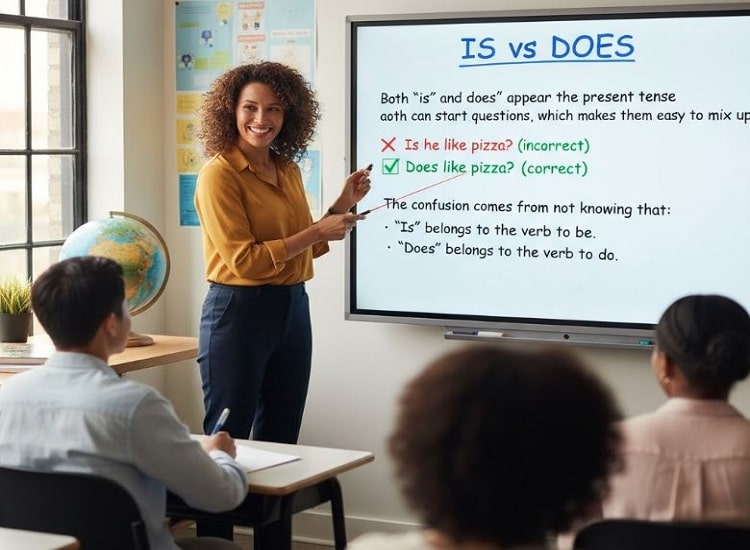If you’ve ever been unsure about when to use “is” or “does,” you’re not alone. These two small words play big roles in English grammar, and many learners confuse them — especially when forming questions or negatives.
In this guide, you’ll learn the difference between “is” and “does,” how to use them correctly, and how to build sentences easily with examples and structures. By the end, you’ll be confident using both forms in your writing and conversations.
Quick Answer
“Is” and “does” both refer to the present tense, but they serve different grammatical purposes:
“Is” is the third-person singular form of the verb “to be.”
It describes states, identity, location, or ongoing actions.Example: She is a teacher.
“Does” is the third-person singular form of the verb “to do.”
It describes actions or works as a helping verb in questions and negatives.Example: She does her homework.
In short:
Use “is” to describe what something is or what’s happening now.
Use “does” to describe what someone does or an action.
Why Learners Confuse “Is” and “Does”
Both “is” and “does” appear in the present tense and both can start questions, which makes them easy to mix up.
For example:
Is he like pizza? (incorrect)
Does he like pizza? (correct)
The confusion comes from not knowing that:
“Is” belongs to the verb to be.
“Does” belongs to the verb to do.
This article will make that distinction clear and show you how to form correct sentences using both.
Is and Does Overview
What “Is” Means and How to Use It
“Is” is the third-person singular of “be” — used with he, she, it, or a singular noun.
It describes:
Identity or occupation:
He is a doctor.
Feelings or state:
She is happy.
Location or position:
The cat is on the bed.
Progressive actions:
He is running.
Passive voice:
The cake is baked every morning.
Existence (there is):
There is a problem.
Quick tip:
If the sentence describes a condition, state, or ongoing event, use is.
What “Does” Means and How to Use It
“Does” is the third-person singular of “do.”
It can be used as:
A main verb to mean “perform” or “carry out”:
He does his homework every day.
An auxiliary (helping) verb for questions and negatives in the present simple tense.
Does she play football?
She doesn’t like cold weather.
An emphatic form to add stress:
He does work hard!
A short answer:
Yes, she does. / No, she doesn’t.
Quick tip:
If the sentence describes an action, habit, or general truth, use does.
Sentence Structures: “Is” vs “Does”
Let’s look at how “is” and “does” behave in different sentence types.
Affirmative Sentences
Is: Subject + is + complement
He is tall.
She is ready.
Does: Subject + does + object or base verb
He does his homework.
She does yoga every morning.
Negative Sentences
Is: Subject + is + not + complement
He is not busy. / He isn’t busy.
Does: Subject + does + not + base verb
He does not like coffee. / He doesn’t like coffee.
Questions
Is: Is + subject + complement?
Is he ready?
Does: Does + subject + base verb?
Does he play guitar?
Short Answers
Yes, he is. / No, he isn’t.
Yes, he does. / No, he doesn’t.
Progressive & Passive Forms
Progressive: “Is” + -ing → He is running.
Passive: “Is” + past participle → The work is done.
Does is not used in these forms.
Comparison Chart: Is vs Does
| Feature | Is | Does |
|---|---|---|
| Verb Type | Form of be | Form of do |
| Used With | He, She, It, Singular nouns | He, She, It, Singular nouns |
| Function | Shows state, identity, condition, progressive, passive | Shows action, helps form questions & negatives |
| Question Form | Is + subject + …? | Does + subject + base verb? |
| Negative Form | Subject + is not (isn’t) | Subject + does not + base verb (doesn’t) |
| Short Answer | Yes, she is. / No, she isn’t. | Yes, she does. / No, she doesn’t. |
| Used in Progressive? | ✅ Yes (He is running) | ❌ No |
| Used in Passive? | ✅ Yes (He is chosen) | ❌ No |
| Example | She is a teacher. | She does her work well. |
Common Mistakes (and How to Fix Them)
| Incorrect | Correct | Why |
|---|---|---|
| Is he like pizza? | Does he like pizza? | “Does” makes present simple questions. |
| He does being tired. | He is tired. | “Is” describes state, not action. |
| She doesn’t plays guitar. | She doesn’t play guitar. | “Does” is followed by base verb. |
| Is he do homework? | Does he do homework? | “Does” forms questions in simple present. |
Tip:
If it’s about “doing something,” use does.
If it’s about “being something,” use is.
Read also more related topics: Do VS Does
Example Sentences
With “Is”
She is at home.
He is not ready yet.
Is it raining outside?
The movie is interesting.
The cake is being baked.
With “Does”
He does his job well.
She doesn’t watch TV.
Does he like swimming?
He does all the cleaning.
Yes, he does!
Practice Exercises
Fill in the blanks with “is” or “does”:
___ he your brother?
She ___ her homework every day.
___ the dog barking now?
He ___ not understand the lesson.
___ she work in a bank?
My mother ___ cooking dinner.
The baby ___ asleep.
___ he play the piano?
She ___ not like spicy food.
___ the book on the table?
Answer Key:
Is
Does
Is
Does
Does
Is
Is
Does
Does
Is
Teaching & Practice Tips
Create flashcards with “is” and “does” sentences and mix them for students to match.
Use a Kahoot or quiz activity for quick recall.
Practice spoken question drills:
Is he coming?
Does he like soccer?
Encourage students to remember:
“Is = state of being. Does = action.”
FAQs
What is the main difference between “is” and “does”?
“Is” describes states or conditions, while “does” describes actions or helps form questions in the present simple tense.
Can “is” and “does” appear in the same sentence?
Yes. Example: Is he doing his homework? (Here, “is” forms the progressive tense, and “do” becomes “doing.”)
Do we use “does” with plural subjects?
No. For plural subjects, use “do.”
Example: They do their homework.
What are the short forms of “is not” and “does not”?
Is not → isn’t
Does not → doesn’t
Can “does” express emphasis?
Yes. Example: He does study hard! — adds emphasis.

